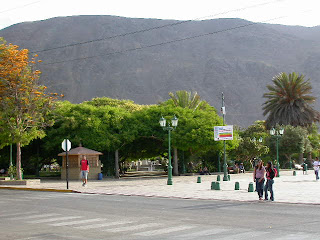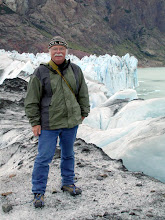I got into Santiago about two hours ago after making the roughly 1700-kilometer drive in little more than two day´s time. Sure, my head is still swirling around in circles regarding the explosion and how that curtailed my trip up north, and I´ll try to get into describing a little of that a bit further on, but right now I need to make a distinction, or if you will, a correction regarding one specific fact: originally I had said that I believed that a fire extinguishor had exploded; in fact, it had been a different sort of cannister - it was one of those emergency "Fix-a-Flat" tire inflators which exploded. Initially all I could tell was that it was some sort of pressurized canned accessory, and looking at the mess of debris I could make out the can shell, some valve apparatus, and a hose mixed in with bits of shrapnel, shredded papers and the drying slime goo that was all over the place. I instinctively figured it was the fire extinguisher. I didn´t even know that the truck was equipped with an emergency tire inflator, and certainly didn´t know it had been placed in the upper glove box, which opens up on the top of the dashboard.
Anyway, I was able to piece together some of the shredded label for that device, and could read that it warned against storing the object anywhere the temperature might reach 50 degrees C., and that the contents were extremely flammable. Considering the latter little bit of information, I guess I should say that I was lucky that the explosion didn´t ignite, and cause the entire vehicle to become engulfed in flames. And I´ve done some rather amateur physics analysis during my drive back to Santiago, and I figured that originally, the can had been packed and pressurized somewhere near sea level. So I figured that driving the vehicle to a significantly higher elevation (San Pedro de Atacama is 2,470 meters, or 8,100 feet above sea level) could cause the critical temperature level to correspondingly drop, as the pressure inside the can increased with the elevation climb.
Anyway, as I drove the long road southward, my mind kept playing over and over the frightening "what if scenario" in which the can didn´t blow until I was off on my drive over the top of the Andean cordillera, the Paso Jama, which reaches a height of 4,600 meters, which is over 15,000 feet, in a couple of places, and the entire ride from San Pedro to Susques, in Argentina, is over 4,000 meters. What if the cannister exploded while I was driving the truck at that elevation, with the blazing hot tropical sun blazing down through the windshield and onto that dashboard? Would I even know what hit me? It would have been like my own personal car bomb blast, a la Gaza or Baghdad, except that it would be happening in a very remote spot. Perhaps it would have caused me to have a heart attack. Maybe my eardrums would be blown out. Shrapnel could have ripped my flesh, and the whole vehicle could have been engulfed in flames, while hurtling down the road at 100 km/hr, careening off the pavement like a real fireball.
So I suppose I should not try to dwell on that scenario so much but rather, to count my blessings instead. I left San Pedro de Atacama with a severely damaged windshield on the day before yesterday. I knew that it would be impossible to drive all the way to Santiago with such impaired vision, and of course, the Carabineros would have stopped me for sure and directed me to the nearest town for repairs.
Well, that´s exactly what I did. I drove straight back down the hill and back to Calama, where I was familiar with the work of the Leo-Loa Parabrisas (Windshield) repair shop. They´d fixed a broken camper shell door for me on my 2005-2006 trip, so I knew that they did good work. And this time was no different from the first time, they had everything changed, a new windshield with all the inspection stickers and registration tags neatly transferred, as well as the all-important auto-toll reader that is required for vehicles using the highways in Santiago. All done in a little over two hours´time. Cost: $170 USD, which I will expect to get reimbursed once Andres has had time to assess the damages.
With the new windshield I was again legal, so I set off from Calama on my concerted drive south, making it back to Taltal before nightfall. Then the next day I figured I´d really have to push myself so as to get into Santiago in prime working-hour time so Andres and his staff could take me in, assess the damages and get me put up for a weekend in the city. So I left Taltal as early as I could, and then proceeded to push south, eventually making it all the way to Los Vilos, a forced drive of nearly 900 kilometers, but only 225 km from Santiago. It meant that today´s drive was a piece of cake.
So now I am soon heading with Andres to lunch and to take my bags to the apartment. I´ll plan to talk to him more about what happens next, and once I know that, I´ll share the news with you.
So that´s it, for now.
Chao.
 Yesterday I went into the port of San Antonio, Chile with my friend Diego Savignone, who is also the caretaker of Las 7 Cabañas where I am staying in El Tabo here on the central Chilean coast. Our purpose was to buy some fresh fish right off of the docks for upcoming meals. The image above shows some of ther activity going on yesterday on the dock that extends out from the main fish market there in San Antonio, with a freighter of South Korean registry in the background.
Yesterday I went into the port of San Antonio, Chile with my friend Diego Savignone, who is also the caretaker of Las 7 Cabañas where I am staying in El Tabo here on the central Chilean coast. Our purpose was to buy some fresh fish right off of the docks for upcoming meals. The image above shows some of ther activity going on yesterday on the dock that extends out from the main fish market there in San Antonio, with a freighter of South Korean registry in the background.









































